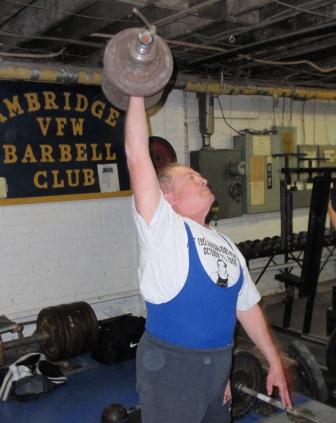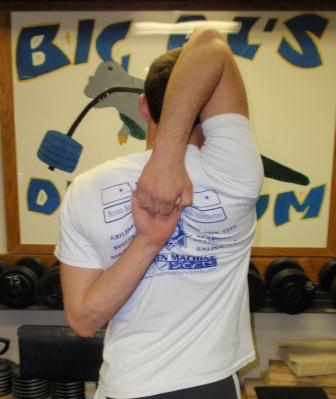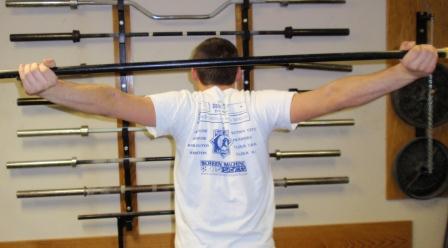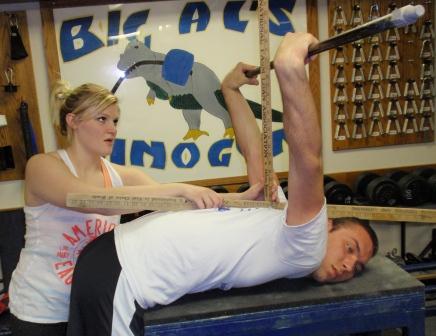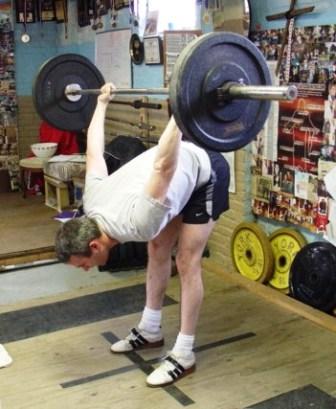Club Challenge
by John McKean
MEET RESULTS
USAWA CLUB CHALLENGE: RITE OF SPRING
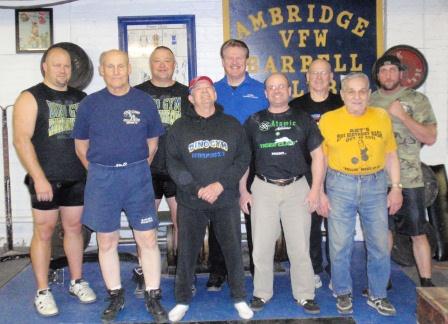
Group picture from 2012 USAWA Club Challenge. (front left to right): Rudy Bletscher, John McKean, Roger LaPointe, Art Montini (back left to right): Chad Ullom, Al Myers, Scott Schmidt, Denny Habecker, Andy Root
For me the first REAL day of Spring began with the bright, beaming smiles of Scott, Denny, Al, Chad, and Rudy as they bounded into the cave-like Ambridge VFW gym to get Art & me out of hibernation! Heck, just the day before it still looked like a typical Western Pennsylvania winter, with gray skies, wind, and snow flurries! Yet the Saturday team challenge had nothing but warming sunshine and crisp, crystal blue skies, which seemed to shout “Get off your lazy butts, it’s time for renewed vigor, a day for record setting!”
First in was an always energetic Roger LaPointe of the Atomic Athletic club from Bowling Green, Ohio. Rog presented each of us with outstanding “old tyme” posters of his upcoming Heavy Lift Championships in May, and was the “early bird” (no, we didn’t give him a worm!) onto the lifting platform. Roger wanted to “warm up” for the main team event by performing a series of record lifts of his specialties with various Olympic style lifts. As usual, his form was crisp and snappy, even inspiring this old achy author to wake up and get in a few records to alert my aging excuse of a body that serious activity was just ahead !
Despite a local bridge having just been closed, Art and Denny zoomed over to the Pittsburgh airport to fetch Al, Chad, and Rudy. Promptly at 11:50 the 3 Kansas stalwarts popped out of the gates, took the speedy drive (Art was at the wheel!) over the Ohio River, and set a new team record in getting ready to lift in the locker room. I swear they flew over in their singlets and warmed up on the jet! (These guys KNOW how to prepare for away meets – they seem to travel somewhere every weekend!).
Andy Root, from nearby New Castle, showed up to treat us to his outstandingly powerful brand of all-round lifting. Andy, you may recall, first appeared last year at Art’s Birthday Bash, with his heart set on his initial USAWA lift to be the Inman Mile (we talked him out of it, and injuries prevented him from trying it today!!). Andy couldn’t coerce team mates to attend with him this time, though. Girlfriend Angela came along, but she was in serious training for a power meet in Ohio next month to perform a world record bench press of 240 pounds at a mere 123 #bwt! We tried & tried, but couldn’t convince the lovely little lady – a very determined and focused powerlifter – to lift today. Fortunately, in putting meet certificates together for the challenge, my wife Marilyn had created an award, “just in case”, for a “team” of one – the “Man Alone” award, which Andy took home!
Phil Rosenstern from our Ambridge club was in for his Saturday workout with his son. Like last year, he didn’t know a USAWA meet was going on. So he promptly entered in order to set a new “Reeves Deadlift” record. As one of the country’s top flight deadlifters for years, Phil made easy work of this difficult lift! He must have inspired team mate Art, who sure never shows his almost 85 years – except, of course, for his characteristic surliness!! Art is already preparing for the Nationals, World’s, and his Birthday Bash!!
It was a sight as Art, Rudy, and I were performing our pullover and press lifts on our own separate platform. The lifts weren’t difficult, but getting each of us old timers back upright off the platform after attempts required the combined efforts of the other two!! I noted, however, that Rudy sure was spry and strong on his swing and hack lifts!
As expected, the big boys, Chad and Al, dominated the heavy lifts. Both showed amazing splitting form in heavy one arm swings, and huge stacking of plates for hack lifts. Chad in particular had bulked up, looking so big that I suspect the guys didn’t really take a jet at all – they just sat on Chad’s massive back and let him flap his huge arms to literally “fly” over from the mid-west! (Ground observers would’ve reported a gigantic “bald eagle” flying above!).
A fine, but all-too-quick day of lifting was punctuated with the annual trip down to the famous Maple Restaurant, home of the proclaimed best hot roast beef sandwich in the country (before we even started lifting, visibly salivating at the mouth, Al told me we could go to ANY restaurant afterwards -except pure vegetarian(!!) – as long as such a place served that fantastic rich beef gravy & gallons of it!). This year, for the first time ever, ALL lifters in the challenge attended the dinner!! And then Sunday we’re on Daylight Savings Time – Spring has truly sprung!!
MEET RESULTS:
USAWA Club Challenge
Ambridge Barbell Club
Ambridge, PA
March 10th, 2012
Meet Director: John McKean
Officials (3 official system used): John McKean, Art Montini, Scott Schmidt, Denny Habecker, Al Myers, Chad Ullom
Lifts: Pullover and Press, Swing – Dumbbell, One Arm, Hack Lift
1. Dino Gym – 2047.0 adjusted points
| Lifter | Age | BWT | P&P | Swing | Hack |
| Al Myers | 45 | 247 | 320 | 140R | 540 |
| Chad UIlom | 40 | 255 | 310 | 150R | 490 |
| Rudy Bletscher | 76 | 218 | 108 | 55R | 220 |
2. Atomic Athletic – 1992.0 adjusted points
| Lifter | Age | BWT | P&P | Swing | Hack |
| Roger LaPointe | 40 | 165 | 154 | 80L | 300 |
| Denny Habecker | 69 | 191 | 194 | 75R | 270 |
| Andy Root | 31 | 180 | 245 | 98R | 510 |
3. Ambridge VFW BBC – 1666.9 adjusted points
| Lifter | Age | BWT | P&P | Swing | Hack |
| John McKean | 66 | 172 | 148 | 55R | 330 |
| Art Montini | 84 | 184 | 118 | 35L | 200 |
| Scott Schmidt | 59 | 246 | 209 | 88R | 253 |
NOTES: BWT is bodyweight in pounds. All lifts recorded in pounds. Adjusted points is the total adjusted points for all team lifters, adjusted for bodyweight and age. L and R designate the arm used in DB swing.
EXTRA LIFTS FOR RECORDS:
John McKean: Curl – Reverse Grip 100#
John McKean: Bent Over Row 202#
John McKean: Pullover – Bent Arm 80#
Roger LaPointe: Snatch – Fulton Bar 99#
Roger LaPointe: Clean and Press – Fulton Bar 127#
Roger LaPointe: Clean and Push Press – Fulton Bar 127#
Roger LaPointe: Snatch – From Hang 152#
Chad Ullom: Swing – Dumbbell, Left Arm 120#
Chad Ullom: Squat – Front 425#
Phil Rosenstern: Deadlift – Reeves 355#
(58 years old, 198# BWT)
